Analysis of Non-Direct Worker Roles in Health and Social Care Settings
VerifiedAdded on 2020/06/05
|6
|1382
|217
Report
AI Summary
This report provides an overview of the roles played by non-direct workers in health and social care environments. It identifies the functions of office staff, maintenance staff, and catering staff within a team, highlighting their contributions to team operations. The report further explains how these non-direct workers contribute to maintaining health, safety, and security in care settings, referencing relevant legislation like the Health and Safety at Work Act 1974 and RIDDOR 1995. Additionally, the importance of supervising and managing non-direct care workers is discussed, emphasizing the impact on service quality and employee morale. The report concludes by summarizing the crucial role of non-direct workers in delivering effective care services, with a focus on interpersonal skills and the need for supervision to ensure patient needs are met. The report also includes a list of references for further reading.
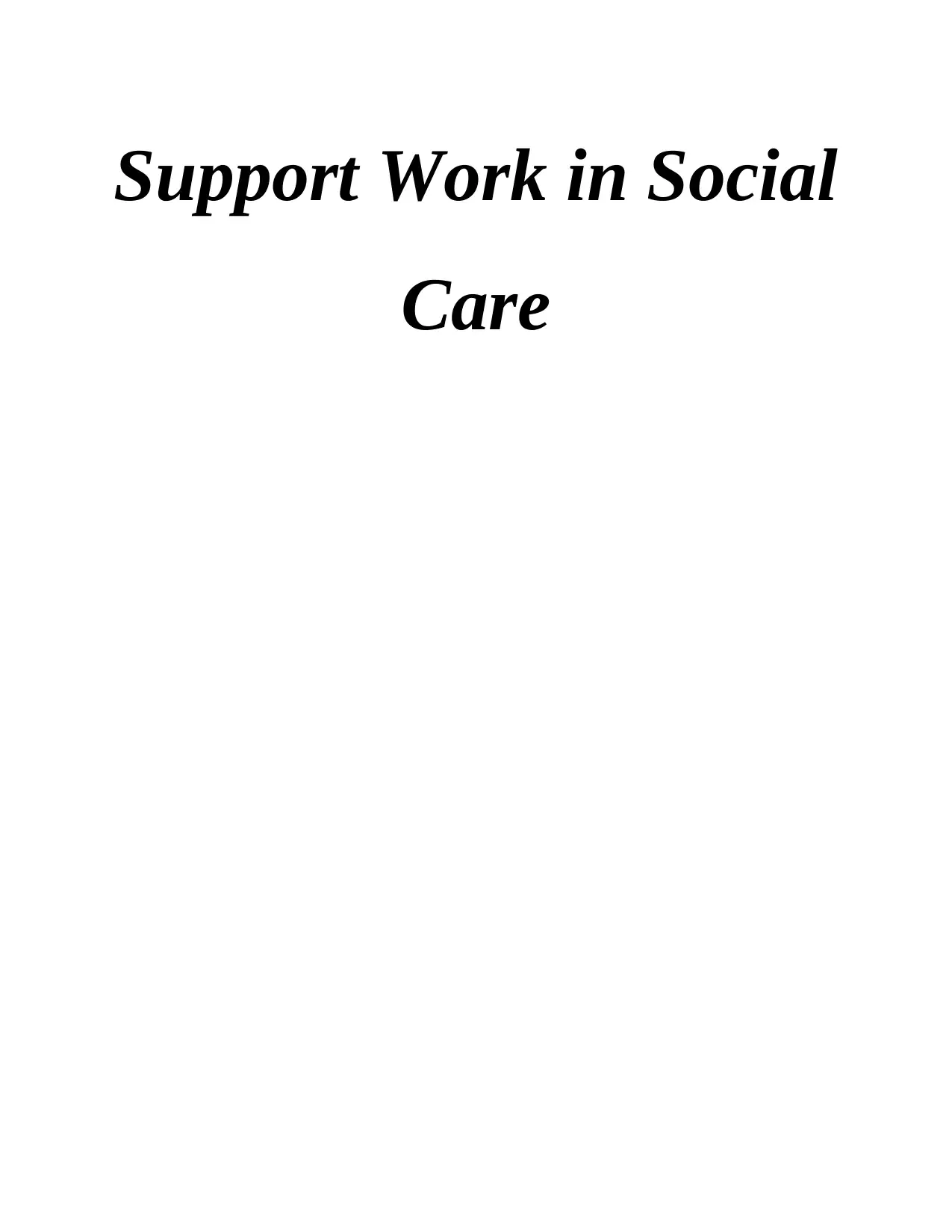
Support Work in Social
Care
Care
Paraphrase This Document
Need a fresh take? Get an instant paraphrase of this document with our AI Paraphraser
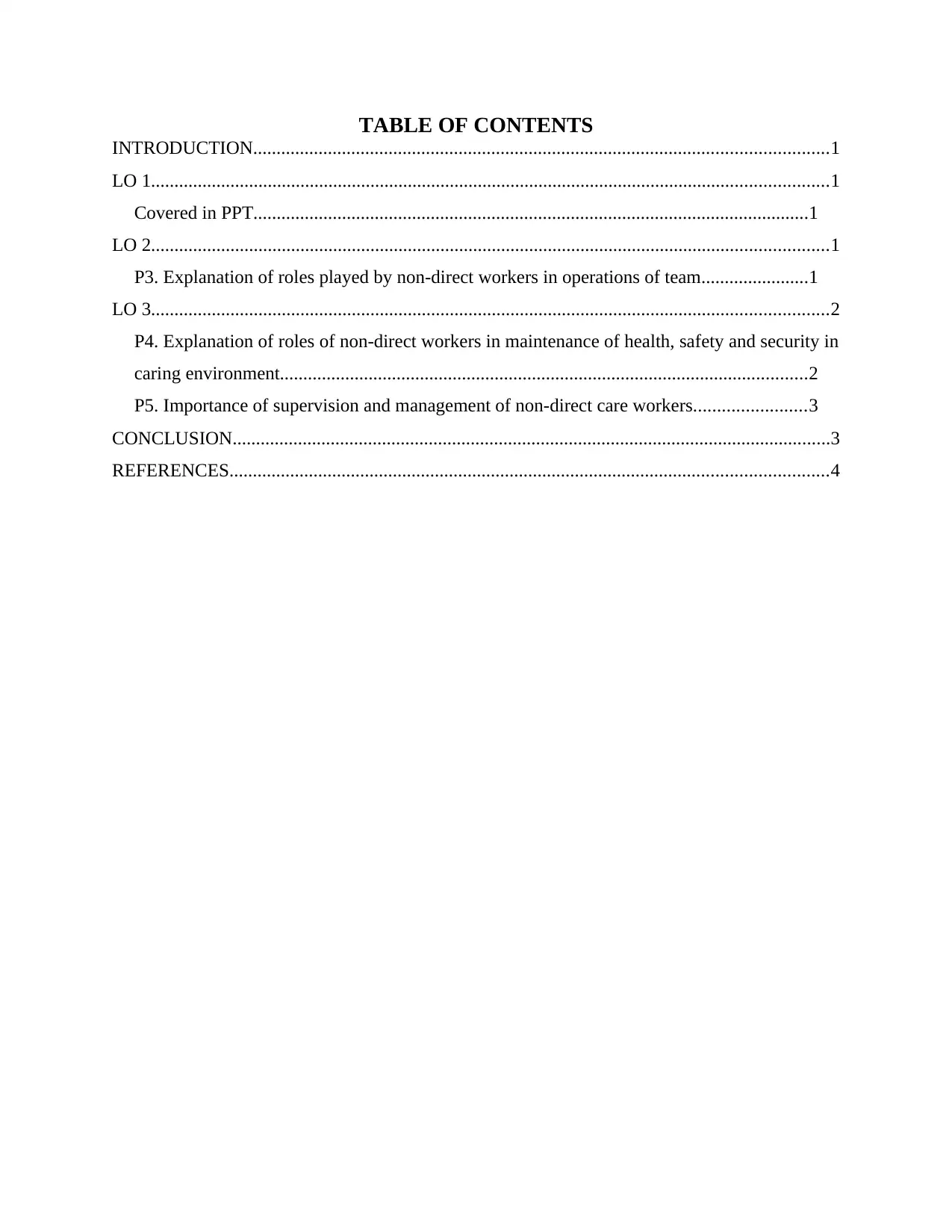
TABLE OF CONTENTS
INTRODUCTION...........................................................................................................................1
LO 1.................................................................................................................................................1
Covered in PPT.......................................................................................................................1
LO 2.................................................................................................................................................1
P3. Explanation of roles played by non-direct workers in operations of team.......................1
LO 3.................................................................................................................................................2
P4. Explanation of roles of non-direct workers in maintenance of health, safety and security in
caring environment.................................................................................................................2
P5. Importance of supervision and management of non-direct care workers........................3
CONCLUSION................................................................................................................................3
REFERENCES................................................................................................................................4
INTRODUCTION...........................................................................................................................1
LO 1.................................................................................................................................................1
Covered in PPT.......................................................................................................................1
LO 2.................................................................................................................................................1
P3. Explanation of roles played by non-direct workers in operations of team.......................1
LO 3.................................................................................................................................................2
P4. Explanation of roles of non-direct workers in maintenance of health, safety and security in
caring environment.................................................................................................................2
P5. Importance of supervision and management of non-direct care workers........................3
CONCLUSION................................................................................................................................3
REFERENCES................................................................................................................................4
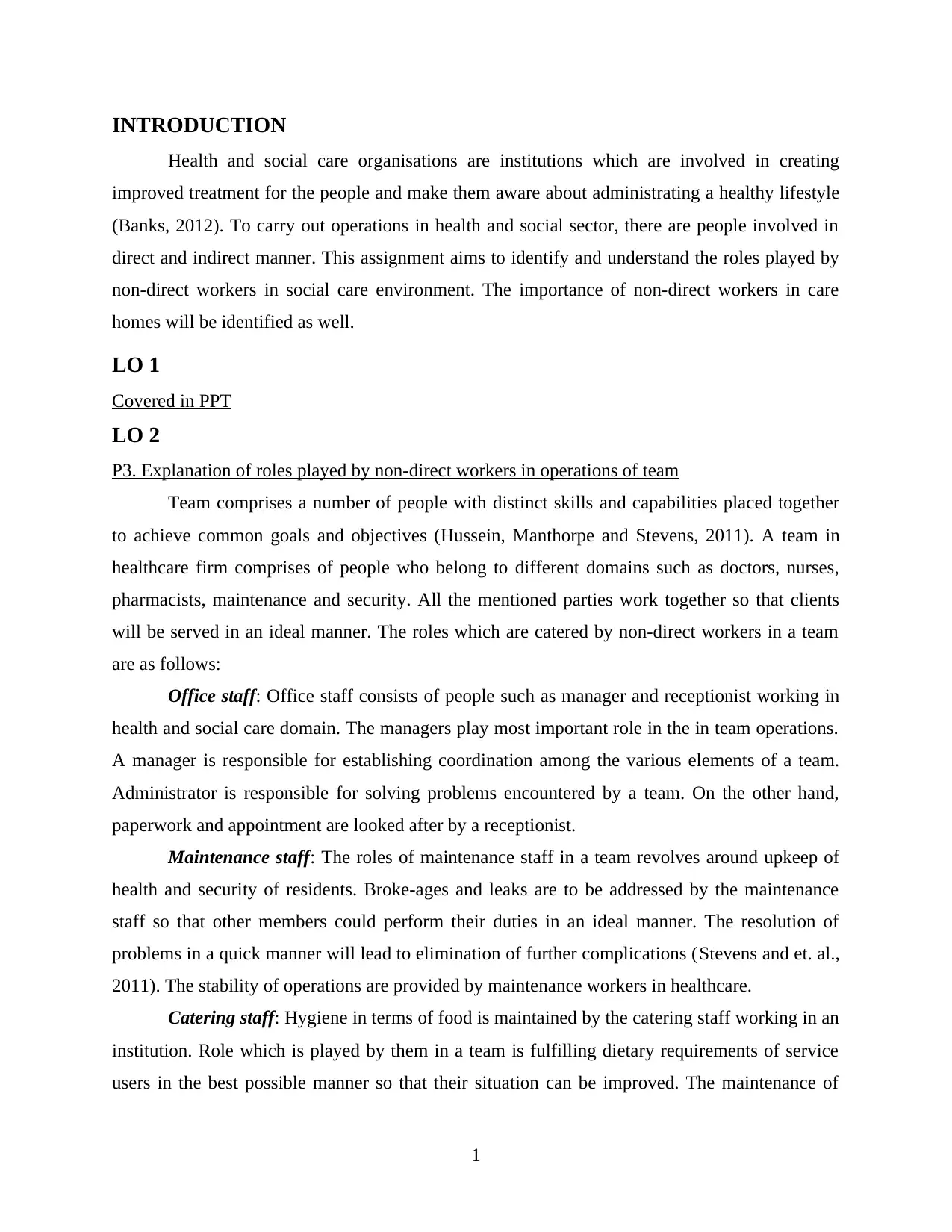
INTRODUCTION
Health and social care organisations are institutions which are involved in creating
improved treatment for the people and make them aware about administrating a healthy lifestyle
(Banks, 2012). To carry out operations in health and social sector, there are people involved in
direct and indirect manner. This assignment aims to identify and understand the roles played by
non-direct workers in social care environment. The importance of non-direct workers in care
homes will be identified as well.
LO 1
Covered in PPT
LO 2
P3. Explanation of roles played by non-direct workers in operations of team
Team comprises a number of people with distinct skills and capabilities placed together
to achieve common goals and objectives (Hussein, Manthorpe and Stevens, 2011). A team in
healthcare firm comprises of people who belong to different domains such as doctors, nurses,
pharmacists, maintenance and security. All the mentioned parties work together so that clients
will be served in an ideal manner. The roles which are catered by non-direct workers in a team
are as follows:
Office staff: Office staff consists of people such as manager and receptionist working in
health and social care domain. The managers play most important role in the in team operations.
A manager is responsible for establishing coordination among the various elements of a team.
Administrator is responsible for solving problems encountered by a team. On the other hand,
paperwork and appointment are looked after by a receptionist.
Maintenance staff: The roles of maintenance staff in a team revolves around upkeep of
health and security of residents. Broke-ages and leaks are to be addressed by the maintenance
staff so that other members could perform their duties in an ideal manner. The resolution of
problems in a quick manner will lead to elimination of further complications (Stevens and et. al.,
2011). The stability of operations are provided by maintenance workers in healthcare.
Catering staff: Hygiene in terms of food is maintained by the catering staff working in an
institution. Role which is played by them in a team is fulfilling dietary requirements of service
users in the best possible manner so that their situation can be improved. The maintenance of
1
Health and social care organisations are institutions which are involved in creating
improved treatment for the people and make them aware about administrating a healthy lifestyle
(Banks, 2012). To carry out operations in health and social sector, there are people involved in
direct and indirect manner. This assignment aims to identify and understand the roles played by
non-direct workers in social care environment. The importance of non-direct workers in care
homes will be identified as well.
LO 1
Covered in PPT
LO 2
P3. Explanation of roles played by non-direct workers in operations of team
Team comprises a number of people with distinct skills and capabilities placed together
to achieve common goals and objectives (Hussein, Manthorpe and Stevens, 2011). A team in
healthcare firm comprises of people who belong to different domains such as doctors, nurses,
pharmacists, maintenance and security. All the mentioned parties work together so that clients
will be served in an ideal manner. The roles which are catered by non-direct workers in a team
are as follows:
Office staff: Office staff consists of people such as manager and receptionist working in
health and social care domain. The managers play most important role in the in team operations.
A manager is responsible for establishing coordination among the various elements of a team.
Administrator is responsible for solving problems encountered by a team. On the other hand,
paperwork and appointment are looked after by a receptionist.
Maintenance staff: The roles of maintenance staff in a team revolves around upkeep of
health and security of residents. Broke-ages and leaks are to be addressed by the maintenance
staff so that other members could perform their duties in an ideal manner. The resolution of
problems in a quick manner will lead to elimination of further complications (Stevens and et. al.,
2011). The stability of operations are provided by maintenance workers in healthcare.
Catering staff: Hygiene in terms of food is maintained by the catering staff working in an
institution. Role which is played by them in a team is fulfilling dietary requirements of service
users in the best possible manner so that their situation can be improved. The maintenance of
1
⊘ This is a preview!⊘
Do you want full access?
Subscribe today to unlock all pages.

Trusted by 1+ million students worldwide
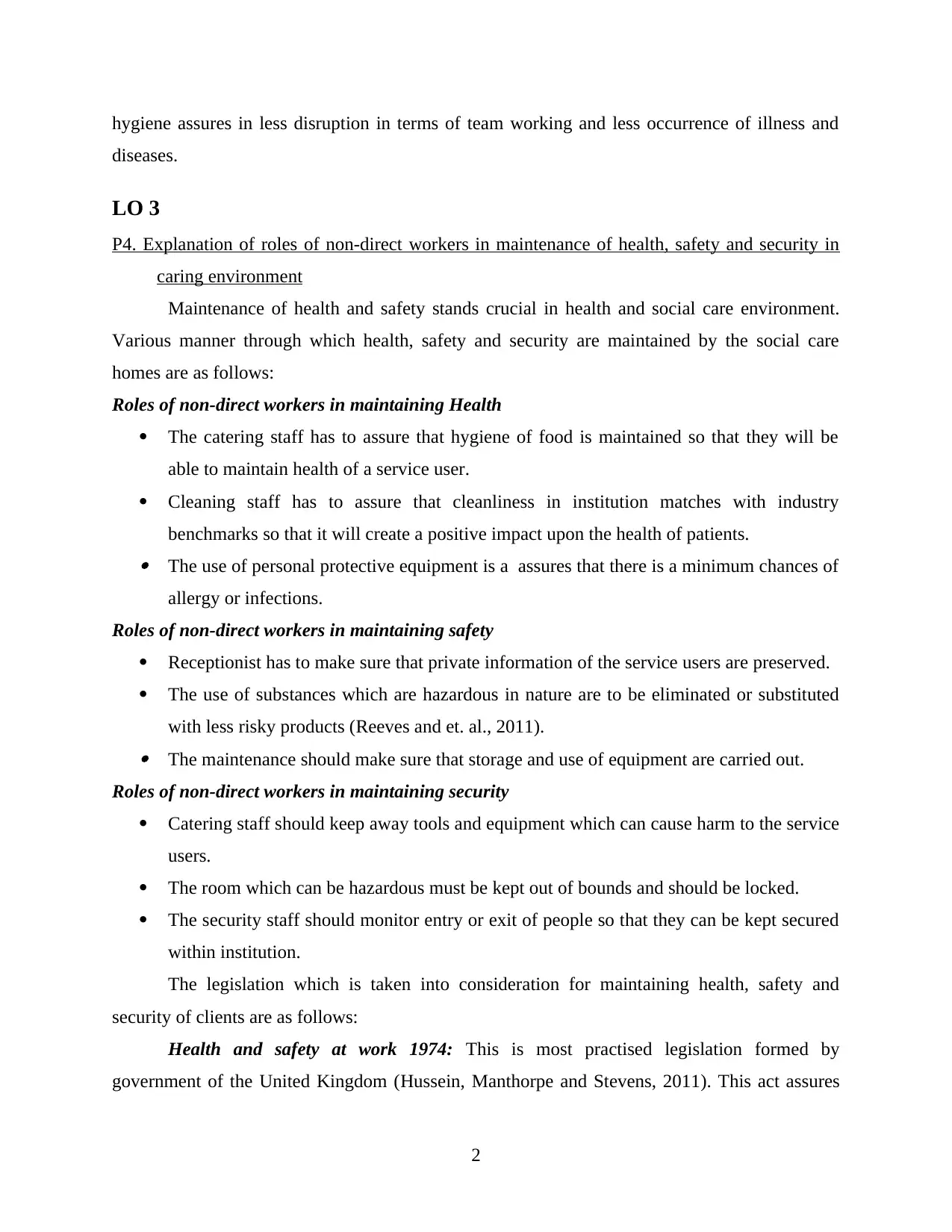
hygiene assures in less disruption in terms of team working and less occurrence of illness and
diseases.
LO 3
P4. Explanation of roles of non-direct workers in maintenance of health, safety and security in
caring environment
Maintenance of health and safety stands crucial in health and social care environment.
Various manner through which health, safety and security are maintained by the social care
homes are as follows:
Roles of non-direct workers in maintaining Health
The catering staff has to assure that hygiene of food is maintained so that they will be
able to maintain health of a service user.
Cleaning staff has to assure that cleanliness in institution matches with industry
benchmarks so that it will create a positive impact upon the health of patients. The use of personal protective equipment is a assures that there is a minimum chances of
allergy or infections.
Roles of non-direct workers in maintaining safety
Receptionist has to make sure that private information of the service users are preserved.
The use of substances which are hazardous in nature are to be eliminated or substituted
with less risky products (Reeves and et. al., 2011). The maintenance should make sure that storage and use of equipment are carried out.
Roles of non-direct workers in maintaining security
Catering staff should keep away tools and equipment which can cause harm to the service
users.
The room which can be hazardous must be kept out of bounds and should be locked.
The security staff should monitor entry or exit of people so that they can be kept secured
within institution.
The legislation which is taken into consideration for maintaining health, safety and
security of clients are as follows:
Health and safety at work 1974: This is most practised legislation formed by
government of the United Kingdom (Hussein, Manthorpe and Stevens, 2011). This act assures
2
diseases.
LO 3
P4. Explanation of roles of non-direct workers in maintenance of health, safety and security in
caring environment
Maintenance of health and safety stands crucial in health and social care environment.
Various manner through which health, safety and security are maintained by the social care
homes are as follows:
Roles of non-direct workers in maintaining Health
The catering staff has to assure that hygiene of food is maintained so that they will be
able to maintain health of a service user.
Cleaning staff has to assure that cleanliness in institution matches with industry
benchmarks so that it will create a positive impact upon the health of patients. The use of personal protective equipment is a assures that there is a minimum chances of
allergy or infections.
Roles of non-direct workers in maintaining safety
Receptionist has to make sure that private information of the service users are preserved.
The use of substances which are hazardous in nature are to be eliminated or substituted
with less risky products (Reeves and et. al., 2011). The maintenance should make sure that storage and use of equipment are carried out.
Roles of non-direct workers in maintaining security
Catering staff should keep away tools and equipment which can cause harm to the service
users.
The room which can be hazardous must be kept out of bounds and should be locked.
The security staff should monitor entry or exit of people so that they can be kept secured
within institution.
The legislation which is taken into consideration for maintaining health, safety and
security of clients are as follows:
Health and safety at work 1974: This is most practised legislation formed by
government of the United Kingdom (Hussein, Manthorpe and Stevens, 2011). This act assures
2
Paraphrase This Document
Need a fresh take? Get an instant paraphrase of this document with our AI Paraphraser
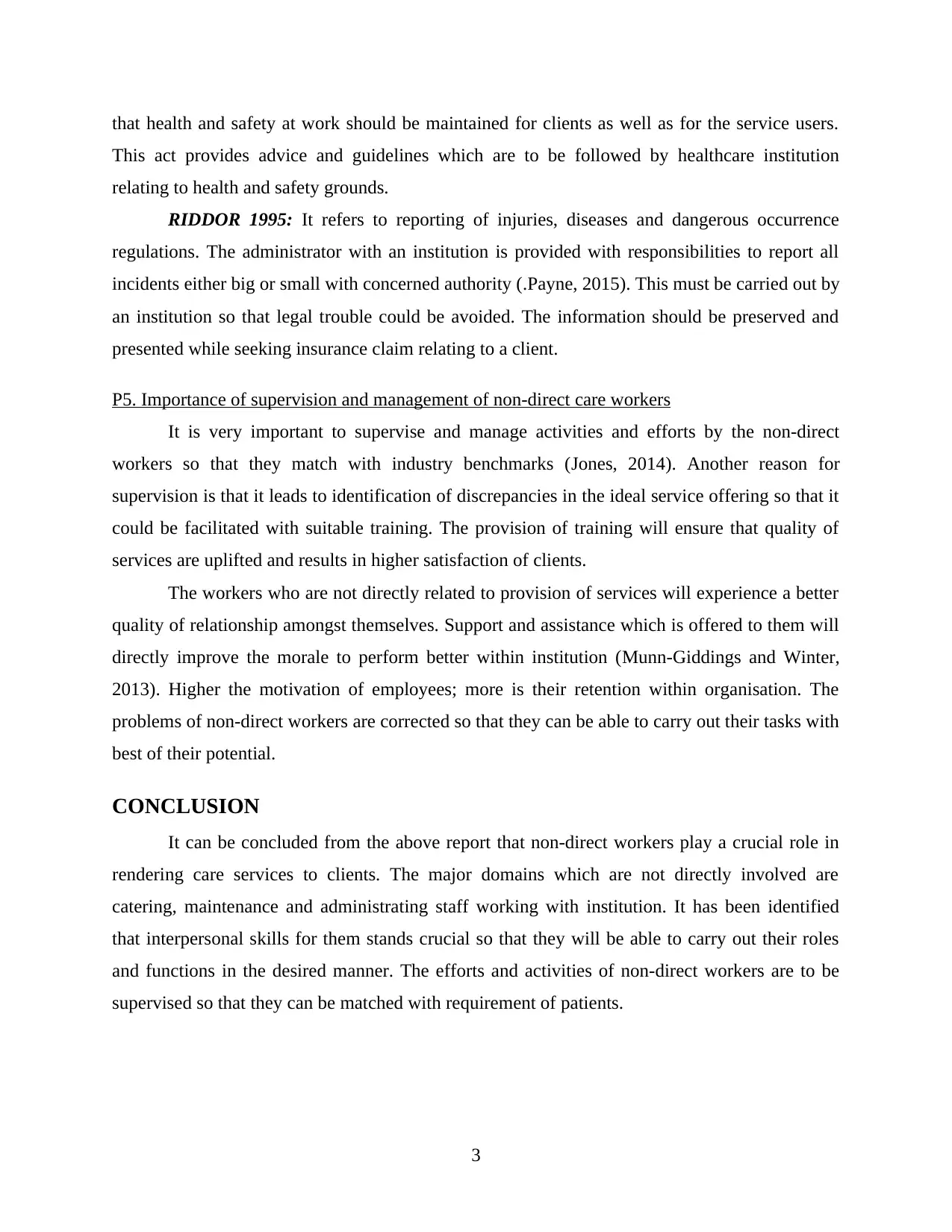
that health and safety at work should be maintained for clients as well as for the service users.
This act provides advice and guidelines which are to be followed by healthcare institution
relating to health and safety grounds.
RIDDOR 1995: It refers to reporting of injuries, diseases and dangerous occurrence
regulations. The administrator with an institution is provided with responsibilities to report all
incidents either big or small with concerned authority (.Payne, 2015). This must be carried out by
an institution so that legal trouble could be avoided. The information should be preserved and
presented while seeking insurance claim relating to a client.
P5. Importance of supervision and management of non-direct care workers
It is very important to supervise and manage activities and efforts by the non-direct
workers so that they match with industry benchmarks (Jones, 2014). Another reason for
supervision is that it leads to identification of discrepancies in the ideal service offering so that it
could be facilitated with suitable training. The provision of training will ensure that quality of
services are uplifted and results in higher satisfaction of clients.
The workers who are not directly related to provision of services will experience a better
quality of relationship amongst themselves. Support and assistance which is offered to them will
directly improve the morale to perform better within institution (Munn-Giddings and Winter,
2013). Higher the motivation of employees; more is their retention within organisation. The
problems of non-direct workers are corrected so that they can be able to carry out their tasks with
best of their potential.
CONCLUSION
It can be concluded from the above report that non-direct workers play a crucial role in
rendering care services to clients. The major domains which are not directly involved are
catering, maintenance and administrating staff working with institution. It has been identified
that interpersonal skills for them stands crucial so that they will be able to carry out their roles
and functions in the desired manner. The efforts and activities of non-direct workers are to be
supervised so that they can be matched with requirement of patients.
3
This act provides advice and guidelines which are to be followed by healthcare institution
relating to health and safety grounds.
RIDDOR 1995: It refers to reporting of injuries, diseases and dangerous occurrence
regulations. The administrator with an institution is provided with responsibilities to report all
incidents either big or small with concerned authority (.Payne, 2015). This must be carried out by
an institution so that legal trouble could be avoided. The information should be preserved and
presented while seeking insurance claim relating to a client.
P5. Importance of supervision and management of non-direct care workers
It is very important to supervise and manage activities and efforts by the non-direct
workers so that they match with industry benchmarks (Jones, 2014). Another reason for
supervision is that it leads to identification of discrepancies in the ideal service offering so that it
could be facilitated with suitable training. The provision of training will ensure that quality of
services are uplifted and results in higher satisfaction of clients.
The workers who are not directly related to provision of services will experience a better
quality of relationship amongst themselves. Support and assistance which is offered to them will
directly improve the morale to perform better within institution (Munn-Giddings and Winter,
2013). Higher the motivation of employees; more is their retention within organisation. The
problems of non-direct workers are corrected so that they can be able to carry out their tasks with
best of their potential.
CONCLUSION
It can be concluded from the above report that non-direct workers play a crucial role in
rendering care services to clients. The major domains which are not directly involved are
catering, maintenance and administrating staff working with institution. It has been identified
that interpersonal skills for them stands crucial so that they will be able to carry out their roles
and functions in the desired manner. The efforts and activities of non-direct workers are to be
supervised so that they can be matched with requirement of patients.
3
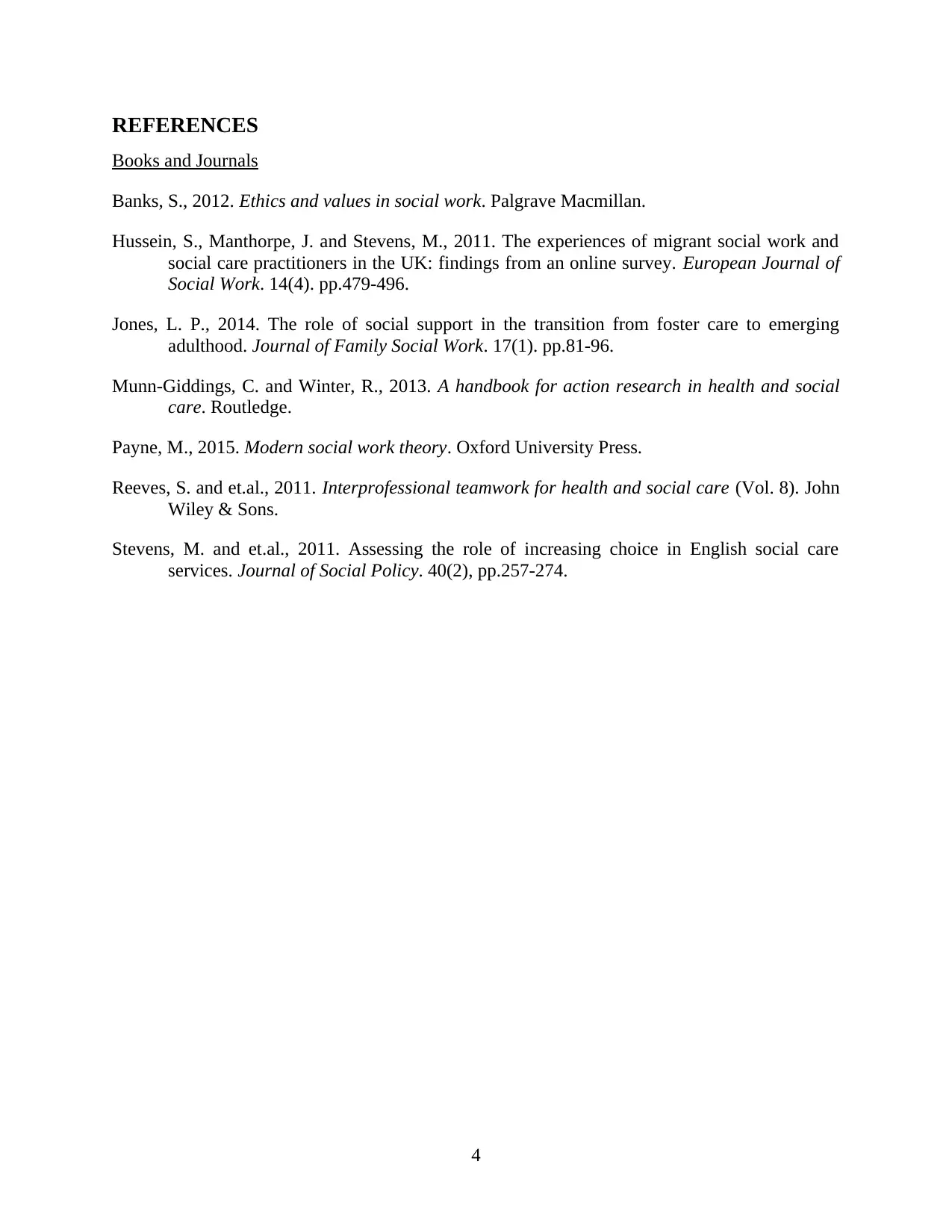
REFERENCES
Books and Journals
Banks, S., 2012. Ethics and values in social work. Palgrave Macmillan.
Hussein, S., Manthorpe, J. and Stevens, M., 2011. The experiences of migrant social work and
social care practitioners in the UK: findings from an online survey. European Journal of
Social Work. 14(4). pp.479-496.
Jones, L. P., 2014. The role of social support in the transition from foster care to emerging
adulthood. Journal of Family Social Work. 17(1). pp.81-96.
Munn-Giddings, C. and Winter, R., 2013. A handbook for action research in health and social
care. Routledge.
Payne, M., 2015. Modern social work theory. Oxford University Press.
Reeves, S. and et.al., 2011. Interprofessional teamwork for health and social care (Vol. 8). John
Wiley & Sons.
Stevens, M. and et.al., 2011. Assessing the role of increasing choice in English social care
services. Journal of Social Policy. 40(2), pp.257-274.
4
Books and Journals
Banks, S., 2012. Ethics and values in social work. Palgrave Macmillan.
Hussein, S., Manthorpe, J. and Stevens, M., 2011. The experiences of migrant social work and
social care practitioners in the UK: findings from an online survey. European Journal of
Social Work. 14(4). pp.479-496.
Jones, L. P., 2014. The role of social support in the transition from foster care to emerging
adulthood. Journal of Family Social Work. 17(1). pp.81-96.
Munn-Giddings, C. and Winter, R., 2013. A handbook for action research in health and social
care. Routledge.
Payne, M., 2015. Modern social work theory. Oxford University Press.
Reeves, S. and et.al., 2011. Interprofessional teamwork for health and social care (Vol. 8). John
Wiley & Sons.
Stevens, M. and et.al., 2011. Assessing the role of increasing choice in English social care
services. Journal of Social Policy. 40(2), pp.257-274.
4
⊘ This is a preview!⊘
Do you want full access?
Subscribe today to unlock all pages.

Trusted by 1+ million students worldwide
1 out of 6
Related Documents
Your All-in-One AI-Powered Toolkit for Academic Success.
+13062052269
info@desklib.com
Available 24*7 on WhatsApp / Email
![[object Object]](/_next/static/media/star-bottom.7253800d.svg)
Unlock your academic potential
Copyright © 2020–2025 A2Z Services. All Rights Reserved. Developed and managed by ZUCOL.





